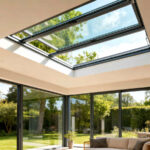
How to Identify the Steel Structure of Victorian greenhouse
The steel structure quality of Victorian greenhouse can be inspected through the types, quality, strength and hardness of galvanized coating, as well as by means of magnet attraction and knocking sound detection. This ensures that you can obtain a Victorian conservatory that suits your needs.

In the current era where material life is relatively affluent, the demand for spiritual life has come to the forefront of public attention. Many people, like me, may also desire to purchase a Victorian conservatory of their own. However, the current market is complex and diverse, with numerous types of conservatories available. How do you distinguish the quality of steel used in Victorian greenhouses among numerous merchants, and how do you choose the right steel material for their conservatory? In the following, I will introduce these points to you.
Firstly, inspect the appearance and surface
treatment.
You can observe with your eyes or use a 5-10 times magnifying glass to check for bubbles, cracks, peeling, rust, etc. Pay special attention to whether there are any damage to the zinc layer at welding points or corners.
Judging the type of zinc coating
Hot-dip galvanizing:
Surface characteristics: slightly granular, may have a few zinc nodules or burrs, and there is zinc coating covering around the screw holes (even blocking the holes).
Corrosion resistance: thick (35-200 μm), uniform and complete, does not change color when immersed in copper sulfate solution.
Cold galvanizing (electro-galvanizing):
Surface characteristics: smooth like a mirror, bright color, only the ends of the steel pipes have zinc coating, and there is no coating inside.
Corrosion resistance: thin (5-15 μm),
prone to scratching and peeling off, short lifespan for rust prevention, only used for non-essential components.
Yongsheng Victorian greenhouse adopts hot-dip galvanizing structure for surface coating treatment, with strong corrosion resistance, and is more suitable for various climate types.
Surface observation is completed, and then the quality of the zinc coating can be tested.
Use a magnetic thickness gauge to detect the thickness of the zinc coating. For hot-dip galvanizing, it should be ≥ 85 μm (in accordance with GB/T 13912 standard), and for key load-bearing components, it is recommended to be ≥ 100 μm.
In addition, mechanical performance tests can also be conducted to test the strength and hardness of the steel material.
Strength and toughness test
Tensile test: determine the yield strength (commonly used greenhouse steel Q235B
≥ 235 MPa), tensile strength (≥ 375 MPa), and elongation rate (≥ 26%).
Bending test: cold bend the steel pipe by 180°, and it is qualified if there is no fracture or delamination (refer to GB/T 232 standard).
Hardness test
Use a Rockwell hardness tester to measure. The hardness of the hot-dip galvanized layer should be ≥ 70 HBR, and the hardness of the base material should comply with the steel grade standard (such as Q235B is 120-150 HB).
If you think such tests are too complicated, there are also simple and convenient identification techniques. All you need is a small magnet to determine the material of the steel.
Carbon steel and hot-dip galvanized steel have strong magnetism, while stainless steel (such as 304) has no magnetism.
Similarly, you can also identify by tapping the steel pipe and listening to the sound.
High-quality steel has a clear and long-lasting sound, while inferior steel may produce a muddy or short sound due to internal defects.
Of course, the most important thing is that when purchasing a Victorian greenhouse, you must carefully distinguish and compare, avoid falling into the trap of low prices, and avoid unnecessary losses to your property safety.
Therefore, I recommend Yongsheng Victorian greenhouse. It not only adopts hot-dip galvanizing + powder coating double-layer protection, but also can be customized to suit your own greenhouse according to different application scenarios.
Moreover, it has a high cost performance, and the service is enthusiastic and patient. I highly recommend it!
Why Choose Us?
- As the first manufacturer in China to introduce the Victorian conservatory design from Europe, we have 36 years of production experience since 1988, and our products are distributed in 68 countries.
- We have a professional team of 8 conservatory design engineers and 60 production workers. We are equipped with 2 hot-dip galvanizing machines, 2 steel shot blasting machines, and 1 spray line.
- Our professional design team can provide theoretical calculation data support for wind pressure resistance, earthquake resistance, and snow resistance of large-scale steel structure conservatories.
- Strict quality control. 8 inspection stages: raw material inspection, cutting and blanking size inspection, welding quality inspection, hot-dip galvanizing quality inspection, spray quality inspection, assembly quality inspection, and packaging quality inspection. Ensuring smooth assembly of the products, no rust, no leakage, and compliance with customer national standards.
- We cooperate with many well-known architectural design companies worldwide.
- Customized services. We can customize according to customer designs and dimensions. We also provide supporting facilities such as electric sunshades and air conditioners.
- We offer installation dispatch services, inspection services, and free replacement of parts. We also present high-value exquisite gifts.
- Video factory tour. You can view the entire production process.
Ready to Bring Your Greenhouse to Life?
Share your ideas and we'll create a custom solution just for you. Your email address will not be published. Required fields are marked *




